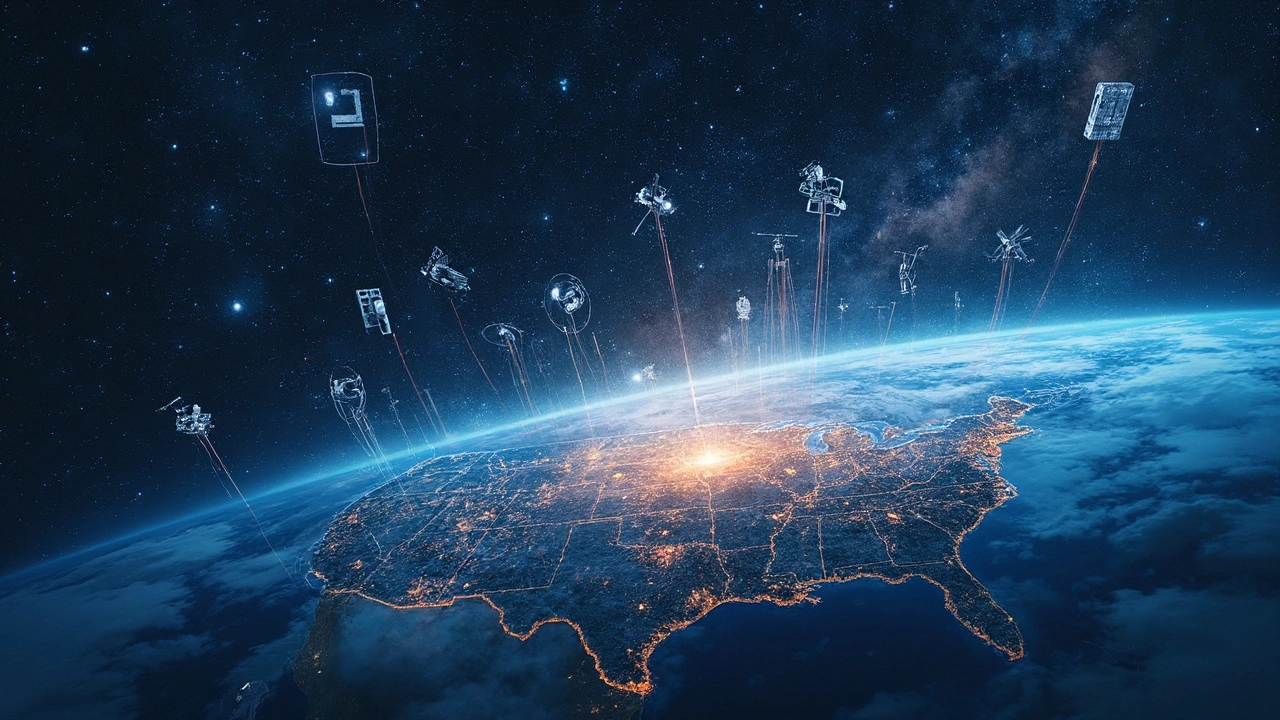Satellites are circling our planet in numbers that would make your head spin. Did you know that there are over 7,500 active satellites up there as of early 2025? That's a lot of metal and tech zooming above us! But who owns these incredible pieces of technology? It turns out, the answer is a mix of governments and private companies, each with their own slice of the space pie.
Historically, satellites were mostly the realm of national governments. Think about agencies like NASA or Russia's Roscosmos—they started it all. However, as technology advanced and commercial interest soared, private companies jumped in. Now we've got SpaceX, Amazon's Kuiper, and OneWeb, to name a few, launching their own satellite networks.
Major Players
When it comes to who owns the most satellites in space, there are some clear major players that dominate the scene. The number one spot belongs to the United States, largely fueled by both government and private companies. Companies like SpaceX have really upped the game with Starlink, which alone accounts for a huge number of satellites.
Following closely is China. They are rapidly expanding their presence in orbit with a mix of governmental and commercial satellites. Their space program, through China National Space Administration (CNSA), launches a significant number monthly.
Government Agencies
Let's talk about some government-backed satellite owners. The U.S. boasts NASA and the DoD, both intensely vested in satellite technology. Meanwhile, Russia continues to be a formidable force with Roscosmos leading their launches.
Private Enterprises
Then there's the private sector, where Elon Musk's SpaceX has been a game changer. Their Starlink project aims to blanket the world in internet; they're already rocking thousands of satellites. Another example is Amazon's Kuiper project, still in its deployment phase but with big ambitions.
One name that keeps popping up is OneWeb, which is focusing on global communications. They might not have the sheer numbers of Starlink, but they're still a key player.
Interesting Stats
| Country/Entity | Number of Satellites |
|---|---|
| United States | Over 3,000 |
| China | Approximately 700 |
| Russia | About 150 |
It’s pretty clear that both governments and private entities have huge stakes in space. Each has their own priorities and goals, but together, they're transforming our world in ways we couldn’t have imagined just a few decades ago.
Government vs. Private Ownership
When it comes to satellites, it's kind of a split between the big guys—governments—and the energetic newcomers—private firms. Governments have been at it longer, launching the first human-made satellite, Sputnik, way back in 1957. Traditional space agencies like NASA and ESA still own a big chunk of the skies. These agencies often focus on research, national security, and communication.
On the flip side, private companies are making waves. Names like SpaceX and their Starlink network are nearly household terms now. Their goal? Mostly bringing fast internet to every corner of the globe. They’ve managed to launch thousands of satellites in just a few years. Elon Musk, the CEO of SpaceX, has been quoted saying,
“SpaceX is committed to providing broadband internet access to underserved areas across the globe.”
Why the Interest?
Governments and private companies have their reasons for satellite ownership. Governments want control over communication and observation capabilities, while companies dive in for potential profits and innovation opportunities.
The Numbers: Who Owns What?
Looking at the numbers, SpaceX alone has over 2,500 satellites in orbit, a staggering increase since their first Dragon flight in 2010. Meanwhile, China isn’t far behind with over 500 satellites, predominantly state-owned. Let's take a closer look at the data.
| Owner | Number of Satellites |
|---|---|
| SpaceX | 2,500+ |
| USA (Government) | 600+ |
| China (Government) | 500+ |
The rise of private satellites is reshaping the industry. New technologies are constantly emerging, promising even more accessibility and connectivity for everyone. As we look to the future, the boundary between government and private sectors in space is getting blurrier—and it's only set to continue.

Purpose and Functionality
Satellites might seem like distant blobs in the sky, but they serve crucial roles in our daily lives. From the moment you check the weather app to navigate with GPS, you're relying on these high-flying tech wonders. Let's break it down a bit more.
Communication Satellites
The communication game changed forever with satellites. Thanks to them, you can stream your favorite shows, video call your friend halfway across the world, or follow a live sports event from another continent. Companies like SpaceX and their Starlink project are big players here, aiming to provide global broadband coverage.
Weather Satellites
Ever wonder how meteorologists predict that sunny picnic weather? It's all about weather satellites. They hover above, snapping cloud pictures and measuring atmospheric conditions. The data is then crunched to forecast weather patterns globally, helping us prepare for anything from sunshine to hurricanes.
Navigation Satellites
Remember the last time you used your phone's maps? A fleet of navigation satellites, like those in the GPS constellation, made that possible. These satellites help pinpoint your exact location on Earth, guiding you on roads and across seas.
Earth Observation and Spy Satellites
Governments often use these for monitoring everything from environmental changes to military movements. They can track deforestation, urban development, and even agricultural fields' health.
Satellites are essential tools that impact everything from entertainment to safety. With companies and governments launching more every year, their utility is only growing.
Future Trends
As we gaze into the future, it becomes clear that the space landscape is evolving fast and furiously. The competition to own the most satellites is heating up, with both governments and private companies in an orbital arms race. What's driving this surge? It's a mix of technological, commercial, and even political motivations.
One of the key trends is the rise of mega-constellations. These are massive networks of small satellites working together to provide global coverage. Think about SpaceX's Starlink or Amazon's Project Kuiper. They're planning to shoot thousands more satellites into low-earth orbit. Why? To deliver high-speed internet to every corner of the globe.
Governments aren't sitting idly by either. Countries like China and India are increasing their own satellite presence to cater to national security and domestic development. More nations are expected to establish space programs, contributing to the crowded skies.
Space Sustainability
With more satellites comes the challenge of debris. If no one's careful, space junk could make certain orbits hazardous. There's a growing focus on space sustainability, and companies are exploring ways to safely de-orbit old satellites before they become obstacles.
- Development of self-fueled satellites that can reposition or self-destruct at the end of their lifespan.
- Regulations requiring companies to manage their satellite debris.
- Investments in technology to clean up existing space junk.
New innovations, like the use of AI to manage satellite systems, may also become more commonplace. This could enhance how efficiently satellites communicate with ground stations and each other.
Finally, international cooperation—or competition—will shape future trends. Collaborations, like those between NASA and the ESA, are promising. But conflicts could emerge as more entities vie for prime orbital real estate.

